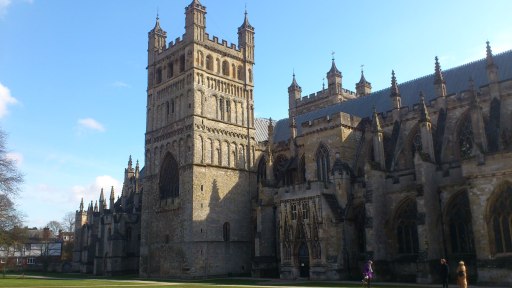I happened to visit both of these stunning cathedrals over the Easter weekend. Although very different, both are triumphs of Medieval Gothic architecture. Salisbury Cathedral is in the county of Wiltshire and Exeter Cathedral in the county of Devon, both south west England.
I took this photograph of Salisbury Cathedral at dusk from the top of a multi-storey carpark! The shot shows how the spire dominates the city sky-line. The sunlight picks out the Norman towers of Exeter Cathedral. Flying buttresses, a key feature of Gothic architecture, are visible alongside the windows.
Modern perceptions of Medieval Europe tend to envisage a drab world gripped by ignorance and Gothic buildings are often imagined to be dark and foreboding. However, anyone who has been inside a Gothic cathedral, seen a rich Medieval tapestry or a bright drinking vessel adorned with a cheeky face will recognise Medieval Europe as a time of colour, vibrancy and innovation.
Gothic architecture originated in France in the 12th century and was popular into the 16th century. The term ‘Gothic’ came about in the Renaissance, when it may have been believed that the architectural style originated in Germany. At the time of its popularity, Gothic style was known as ‘French Work’.
The defining feature of Gothic architecture is the pointed arch. Romanesque rounded arches had been commonly used in ecclesiastical architecture before the arrival of the Gothic. The weight-bearing properties of the pointed arch are much greater than the rounded Romanesque arches; pointed arches allowed vaults to be raised much higher than had previously been possible, allowing for the staggeringly high ceilings seen in Gothic structures. It has been suggested that the pointed arch was adopted from the Islamic world.
Pointed arches with their supporting tracery also allowed buildings to have larger and more numerous windows. In the days before electric lights, the effect of so much light in an inside space must have been astounding.
Salisbury Cathedral has the tallest church spire in the United Kingdom and the oldest working clock in the world. Unlike Exeter which incorporated an earlier structure, Salisbury was built entirely in the Gothic style and was completed in 1320.
The first Exeter Cathedral was Norman and much of the original structure was later incorporated into a new Gothic building. With the design taking inspiration from Salisbury Cathedral, a Gothic cathedral was completed in the 15th century. The two square towers shown in the photograph are remnants of the original Norman building.
It is fascinating the consider the effect a building such as Salisbury Cathedral must have had on a Medieval person. Even today when cities around the world are strewn with teetering skyscrapers, the enormity of Salisbury’s spires are still a jaw-dropping sight. That such architectural magnificence could be achieved without the use of cranes or power tools is truly humbling. For pilgrims visiting Salisbury in its Medieval hey-day, there could have been no doubt that this was a palace of God.
Photographs my own



I remember fondly my visit to Salisbury Cathedral 9 years ago. Stunning architecture, great purity of form. “French work” or not, my biased opinion is that the English did the best work in the genre, precisely because they emphasised form over detailing, while the French did the opposite.